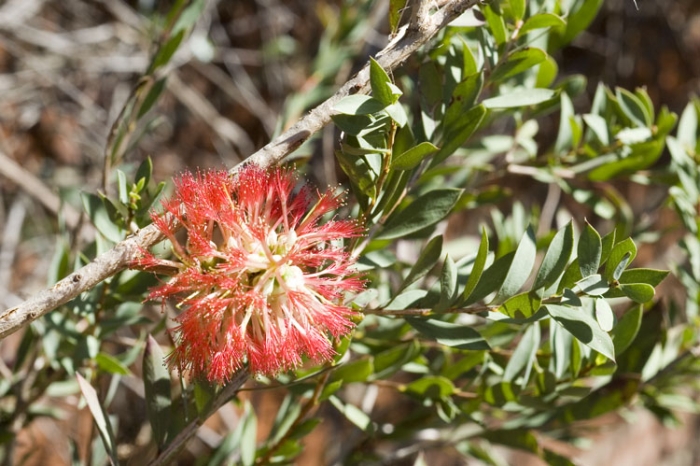Claw Honey-Myrtle
(Melaleuca macronychia)
Claw Honey-Myrtle (Melaleuca macronychia)
/
/

Murray Fagg
CC BY 3.0 au
Image By:
Murray Fagg
Recorded By:
Copyright:
CC BY 3.0 au
Copyright Notice:
Photo by: Murray Fagg | License Type: CC BY 3.0 au | License URL: https://creativecommons.org/licenses/by/3.0/au/deed.en | Uploader: Gderrin | Publisher: Wikimedia Commons | Title: Melaleuca_macronychia_flowers.jpg | Notes: User created page with UploadWizard |




Estimated Native Range
Summary
Melaleuca macronychia, commonly known as Claw Honey-myrtle, is an evergreen shrub native to the wetlands, swamps, and seasonally inundated plains in the Southwest of Western Australia. It typically grows to a height and width of 6-10 feet (1.8-3 meters), forming a dense, rounded shape. The Claw Honey-myrtle is notable for its striking red flower spikes that bloom in summer and fall, which are highly attractive to nectar-feeding birds and insects. The bark is papery and can peel off in strips, while the leaves are small and aromatic when crushed.
The plant is valued for its long-lasting, showy red flowers and its ability to adapt to a range of garden conditions. It is often used in urban landscapes, as a feature shrub in gardens, and for habitat restoration projects. Claw Honey-myrtle thrives in full sun to part shade, requiring low to medium water once established, and prefers well-drained soils. While it is a hardy species, it is susceptible to root rot if overwatered or planted in poorly drained soils. It is less commonly grown on the more humid east coast but can succeed there in well-drained soil with a sunny aspect.CC BY-SA 4.0
The plant is valued for its long-lasting, showy red flowers and its ability to adapt to a range of garden conditions. It is often used in urban landscapes, as a feature shrub in gardens, and for habitat restoration projects. Claw Honey-myrtle thrives in full sun to part shade, requiring low to medium water once established, and prefers well-drained soils. While it is a hardy species, it is susceptible to root rot if overwatered or planted in poorly drained soils. It is less commonly grown on the more humid east coast but can succeed there in well-drained soil with a sunny aspect.CC BY-SA 4.0
Plant Description
- Plant Type: Shrub
- Height: 6-10 feet
- Width: 6-10 feet
- Growth Rate: Moderate
- Flower Color: Red
- Flowering Season: Summer, Fall
- Leaf Retention: Evergreen
Growth Requirements
- Sun: Full Sun, Part Shade
- Water: Medium
- Drainage: Medium
Common Uses
Bee Garden, Bird Garden, Butterfly Garden, Hummingbird Garden, Low Maintenance
Natural Habitat
Wetlands, swamps, and seasonally inundated plains in the Southwest of Western Australia
Other Names
Common Names:
Scientific Names: , Melaleuca macronychia,
GBIF Accepted Name: Melaleuca macronychia Turcz.